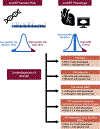Genetic and phenotypic profiling of supranormal ejection fraction reveals decreased survival and underdiagnosed heart failure
- PMID: 35278270
- PMCID: PMC9464795
- DOI: 10.1002/ejhf.2482
Genetic and phenotypic profiling of supranormal ejection fraction reveals decreased survival and underdiagnosed heart failure
Abstract
Aims: Individuals with supranormal left ventricular ejection fraction (snLVEF; LVEF >70%) have increased mortality. However, the genetic and phenotypic profile of snLVEF remains unknown. This study aimed to determine the relationship of both snLVEF genetic risk and phenotype with survival and underdiagnosed heart failure (HF).
Methods and results: A snLVEF genetic risk score (GRS) was applied and cases of snLVEF were identified in 486 754 individuals across two population-based cohorts (BioMe Biobank and UK Biobank). The snLVEF GRS and phenotype were evaluated for association with survival, as well as HF diagnosis, markers, symptoms, and medications. Of 486 754 participants, the median age was 58 years, 20 069 (4.1%) died, and 10 088 (2.1%) had diagnosed HF. Both snLVEF GRS (hazard ratio [HR] 1.1 for top 10% vs. bottom 10% GRS; p = 0.002) and phenotype (HR 1.4; p = 0.003) were associated with increased all-cause mortality. Both snLVEF GRS and phenotype were associated with reduced HF diagnosis (odds ratio [OR] 0.97 and OR 0.63, respectively; both p ≤0.002). However, the snLVEF GRS and phenotype were both associated with elevated brain natriuretic peptide (BNP) levels (146 and 185 pg/ml increase, respectively; p <0.001), including 268 out of 455 (59%) individuals with snLVEF phenotype who had BNP >100 pg/ml. Among 476 666 participants without HF diagnoses, snLVEF GRS and phenotype were associated with increased HF symptoms (e.g. exertional dyspnoea OR 1.4 and OR 1.3; p <0.003) and HF medications (e.g. loop diuretic OR 1.2 and OR 1.03; p <0.02). Associations were consistent in hypertensive individuals without cardiac comorbidities.
Conclusions: Genetic predisposition to and presence of snLVEF are associated with decreased survival and underdiagnosed HF.
Keywords: Biobank; Electronic health record; Genetic risk score; Heart failure; Supranormal ejection fraction; Underdiagnosis.
© 2022 European Society of Cardiology.
Conflict of interest statement
Figures



Comment in
-
Heart failure with supra-normal left ventricular ejection fraction: distinct polygenic bases of an unrecognized phenotype.Eur J Heart Fail. 2022 Nov;24(11):2128-2130. doi: 10.1002/ejhf.2657. Epub 2022 Sep 7. Eur J Heart Fail. 2022. PMID: 35999647 No abstract available.
References
-
- Wehner GJ, Jing L, Haggerty CM, Suever JD, Leader JB, Hartzel DN, Kirchner HL, Manus JNA, James N, Ayar Z, Gladding P, Good CW, Cleland JGF, Fornwalt BK. Routinely reported ejection fraction and mortality in clinical practice: Where does the nadir of risk lie? Eur Heart J 2020; 41: 1249–1257. 10.1093/eurheartj/ehz550 - DOI - PMC - PubMed
-
- Maredziak M, Bengs S, Portmann A, Haider A, Wijnen WJ, Warnock GI, Etter D, Froehlich S, Fiechter M, Meisel A, Treyer V, Fuchs TA, Pazhenkottil AP, Buechel RR, Kaufmann PA, Gebhard C. Microvascular dysfunction and sympathetic hyperactivity in women with supra-normal left ventricular ejection fraction (snLVEF). Eur J Nucl Med Mol Imaging 2020; 47: 3094–3106. 10.1007/s00259-020-04892-x - DOI - PubMed
Publication types
MeSH terms
Grants and funding
LinkOut - more resources
Full Text Sources
Medical
Research Materials
Miscellaneous

